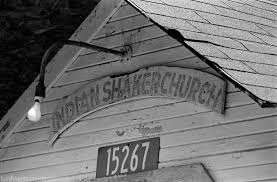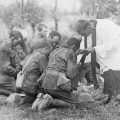
( – promoted by navajo)
One of the largest pan-Indian spiritual movements during the past two centuries has been the Native American Church. This is a religious movement which began to emerge among the Indian nations in Oklahoma during the late nineteenth century. In its ceremonies the Native American Church incorporates elements of Christianity with some traditional Native American beliefs. In looking at the history of the Native American Church, the common myth of religious freedom in the United States is challenged, if not shattered. It is a history of struggle against repression. The reason for this oppression ostensibly centers on the use of peyote as a sacrament.
Peyote is a small cactus which grows in Texas and Mexico. Peyote contains numerous alkaloids, including mescaline. While peyote has often been confused with the mescal bean and with mescaline, it is not the same. It is the combination of alkaloids which contribute to the effects of eating peyote.
The reaction to ingesting peyote begins with wakefulness, mild analgesia, and a sensation of fullness in the stomach or loss of appetite. Sometimes there may be active nausea, a feeling of tightness in the chest, and heightened sensitivity to nuances of sound, color, form, and texture. For some people, the use of peyote may include visions. Visions, of course, are an important part of traditional Native American spirituality.
The all-night Native American Church ceremony takes place in a tipi, a hogan, or a lodge. It includes a sacred fire, a mound of earth which serves as an altar, and a grandfather peyote button. During the ceremony peyote songs are sung, prayers are offered, cedar is burned, tobacco is smoked, and peyote is ingested.
Native Americans contrast the difference between Christianity and the peyote ceremony by saying that the Christians go into their churches and talk about God, while in the Native American Church meeting the people talk to God.
The Native American Church has incorporated many Christian elements into its ceremonies, including the idea of six days of creation followed by one day of rest. With regard to this “one day of rest”, one peyote roadman has said: “But this is an overlay, superimposed on our original awareness that every day is a holy day.”
In spite of the fact that the Native American Church has also incorporated many aspects of Christianity into its services, the ceremony has been condemned by many Christian missionaries as a “hindrance” to civilization. Both federal and state governments have responded to the missionaries’ concerns by aggressively persecuting the Church and its members.
Peyote meetings are held most often for the sake of curing. Traditional Indians see illness as a product of spiritual forces and therefore the cure for illness needs to involve spiritual forces. Some people feel that four curing meetings are needed for a complete recovery and some hold meetings to give thanks for being cured. Meetings may also be held to insure good health, for weddings, for blessing a new home, and for good luck and good fortune to the family.
Those who follow the peyote road feel that the use of alcohol is not compatible with this way of life. In fact, there are many who feel that peyote can be used to cure alcoholism. Sobriety is often stressed as an important part of peyote spiritualism. The eminent research psychiatrist Karl T. Menninger has concluded that peyote “is a better antidote to alcohol than anything the missionaries, white man, the American Medical Association, and the public health services have come up with.”
One of the concerns expressed by the uninformed is that peyote is addictive and therefore is a dangerous drug. Researchers who have studied peyote, however, have found that there is no evidence for physiological dependence, and therefore there can be no evidence for addiction. In one study of addiction which used an addictive liability index, researchers found that alcohol is most addictive (an index of 21), followed by opium (an index of 16), cocaine (an index of 14), and marijuana (an index of 8). Peyote has an index of 1. The researchers concluded that peyote should not be classified as a narcotic.
Many Native Americans point out that many Christians use a highly addictive drug – alcohol – as the sacrament in their ceremonies and that this use of alcohol has been tolerated in places and in times when alcohol use has been illegal. Many Native Americans feel that their use of peyote as a sacrament in ceremonies should be given the same tolerance.
The European opposition to peyote began relatively early. In 1620 the Catholic Inquisition in New Spain declared that the use of peyote “is an act of superstition condemned as opposed to the purity and integrity of our Holy Catholic Faith.”
Another concern about the religious freedom of the Native American Church is that the government often requires evidence of church membership and seeks to determine who is a bona fide church member and who is not. The maintenance of membership lists, the issuing of membership cards, and having membership requirements runs counter to traditional Indian culture. In order to combat the active legal suppression of the religion, the Native American Church began to legally incorporate in the early twentieth century. This has given it more legal standing.
In many states, those opposed to peyote have taken a different approach to limit the activities of the Native American Church. In many instances, the law requires that participation in Church ceremonies be limited to people who can prove that they have sufficient Indian blood, usually designated as one-fourth. In addition, this “blood” quantum must be from federally recognized tribes. In this way, the Native American Church is racially segregated by law. There are no other religions in the United States which are racially segregated by law.
At the present time, people in the United States have the freedom to believe in whatever religion they choose. However, the practice of religion – the ceremonies, the sacraments – are not freely allowed under the law. To paraphrase one Supreme Court Justice, the freedom to practice different religions, particularly that of the Native American Church, is a luxury which we cannot afford. The Court sees freedom of religion in belief, but feels the translation of beliefs into ceremonies should be restricted.
The struggle for religious freedom for the Native American Church has been fought on four basic fronts: (1) in the Courts, including state courts, federal courts, and the Supreme Court, (2) in Congress, (3) in state legislatures, and (4) in tribal councils. The fifth area has been in educating the public, both Indian and non-Indian, about the Native American Church.



Leave a Reply